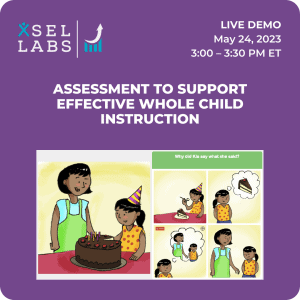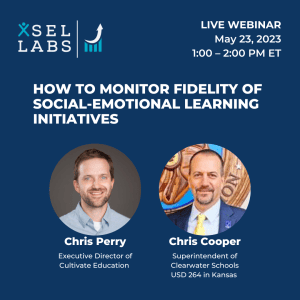Social Emotional Learning: Playing the Long Game
These are difficult days for most residents of planet Earth.
Because of all we have been through together, educators and parents are rightly concerned about the social and emotional well-being of students. As I have discussed elsewhere, conversations about children’s “social and emotion well-being” are really about two largely distinct topics: mental health and social emotional learning.
I am trained as a clinical psychologist and I am deeply involved in the SEL world, so I am a respecter of both perspectives. But I would argue that it is really important to be clear about what we’re talking about when we talk about social and emotional well-being. Are we putting out fires or playing the long game?
Defining the Two Meanings of “Social and Emotional Well-Being”
If social and emotional well-being refers to mental health and social emotional learning, let us spend a moment clarifying what each term means.
Mental health refers broadly to the burden of psychological symptoms children carry to school with them that can interfere with their ability to learn and succeed. These include the effects of trauma, including symptoms of anxiety and depression.
Social emotional learning refers to the competencies we affirmatively want children to develop to be constructive participants in collective life and successful students and members of the community. Social and emotional competencies include things like understanding others’ feelings and points of view, constructively resolving conflict, and managing emotions. For more, see CASEL’s revised definition.
At first blush, these two terms seem like the same thing. A closer look reveals that they are not, and each lead to different ways of understanding and working with children.
Implications for Assessment of Mental Health and Social Emotional Learning
The goals, mechanics, and outcomes of assessment can be radically different depending on which definition of social and emotional well-being prevails. As summarized in the table below, a mental health approach is generally focused on identifying and diagnosing students with emotional or behavioral problems and identifying supports to help reduce their symptoms and improve functioning. A social emotional learning approach is focused on benchmarking the competencies of all students to help educators figure out what to teach to whom, with the goal of nurturing the competencies we want all students to develop.
Quite different, no?
| Dimension | Mental Health | Social Emotional Learning |
| Overall Objective | Measure symptoms that interfere with functioning | Measure competencies that are the focus of instruction |
| Student Focus | Students with problems | All students |
| Department of Origin | Special education, student services | Curriculum and instruction, often in collaboration with school counseling |
| Goals | Problem identification: 1. Screening: Identify children with or at-risk of a disorder 2. Diagnosis: Determine whether a child has a disorder 3. Treatment planning: Determining intervention strategy (Tier II or Tier III) |
Learning diagnostic: 1. Benchmarking: Early measure of competence level 2. Instructional planning: Determining what to teach to whom 3. Progress monitoring: Measuring progress in response to instruction |
| Assessments Used | 1. Symptom checklists 2. Behavioral screeners 3. Diagnostic assessments |
1. Student competence assessments 2. Sometimes climate assessments |
| Practice Consequences | • Diagnosis • Placement • Treatment plan |
• Differentiated instruction • Tailored use of Tier I resources • Tier II and III intervention planning |
Implications for Action for Mental Health and Social Emotional Learning
Okay, so the definition of social and emotional well-being has implications for assessment. What about intervention—the stuff adults do when they get the assessment results? As you might expect, the implications for intervention are stark too, as you can see in the table below. A mental health approach is focused on supporting children with clinically significant social and emotional problems with evidence-based therapeutic interventions that aim to reduce symptoms and improve functioning. A social emotional learning approach is focused on applying evidence-based practices and principles to support the development of desirable competencies in all students.
| Dimension | Mental Health | Social Emotional Learning |
| Overall Objective | • Reduction in symptoms • Improvement in functioning |
Growth in competencies
|
| Student Focus | Students identified with problems | All students |
| Department of Origin | Special education, student services | Curriculum and instruction, often in collaboration with school counseling |
| Goals | 1. Reduce symptom severity 2. Remove barriers to success 3. Increase functioning, particularly ability to participate in instruction |
1. Teach competencies 2. Nurture skills needed for success 3. Equip students with tools to help them navigate challenges successfully |
| Interventions Used | 1. Evidence-based therapies 2. Behavior management 3. Remediation 4. Clinical treatments |
1. SEL curricula 2. SEL instructional strategies 3. Integration of SEL with academic instruction |
The Time Horizon
Social and emotional well-being as mental health has a very different time horizon than social and emotional well-being as SEL. Mental health problems have an urgency and immediacy wherein rapid diagnosis and prompt treatment are important. Social and emotional competence is a long-term commitment to teaching competencies. Mental health is about dousing fires, now. Social emotional learning is about growing competencies over the long haul.
How Are These Two Kinds of Social and Emotional Well-Being Related?
Mental health and social emotional learning are different in their meaning, consequences, and time horizon. But that does not mean they are unrelated. Social and emotional competencies help children manage the difficulties life brings and maintain good mental health. Playing the long game, teaching all students social and emotional competence, therefore serves the aim of supporting children’s mental health.
Which is Better?
Most would agree that we should not choose between assessing and addressing mental health and social and emotional competencies. Both are important and in a healthy society, adults are looking out for both kinds of social and emotional well-being in children.
The challenge of the moment is this: concern about trauma and its consequences is so acute that it would be very easy to put all of our time and resources into putting out mental health fires, and lose sight of the long game. To come out of this in a way that children are equipped to manage the world they are inheriting from us, though, demands that we keep our eyes on the long-term goal of nurturing the competencies we know children need to succeed.
And that means, in the midst of a pandemic, with constraints that range from the budgetary to the operational, continuing to find ways to assess and address the social and emotional competencies that, over the long haul, will help today’s children become tomorrow’s vibrant adults.



